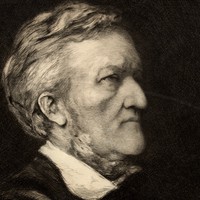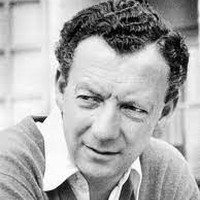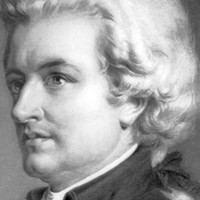Mozart’s Symphony No. 39

Sponsored By
- May 2, 2015


Sponsored By


(Duration: 17 min)
The great love of Richard Wagner’s life was Cosima, the illegitimate daughter of Franz Liszt and his longtime mistress. She was 24 years younger than Wagner, and they were both married to others when they met, but still they consummated their infatuation in 1864, and she gave birth to Wagner’s daughter Isolde the next year. Cosima spent long periods at Wagner’s house at Tribschen, overlooking Lake Lucerne in Switzerland, and they had three children together by the time her divorce went through in 1870, allowing them to marry a month later.
Wagner capped that momentous year with an extraordinary birthday present for his thirty-three-year-old bride. On Christmas morning (she was actually born on the 24th, but she celebrated her birthday a day later), he woke up Cosima with the sounds of a fifteen-piece chamber orchestra piled onto the staircase outside her bedroom. She described the experience in her diary:
When I woke up I heard a sound, it grew ever louder, I could no longer imagine myself in a dream, music was sounding, and what music! After it had died away Richard came in to me with the five children and put into my hands the score of his Symphonic Birthday Greeting. I was in tears, but so, too, was the whole household; Richard had set up an orchestra on the stairs and thus consecrated our Tribschen forever! The Tribschen Idyll — thus the work is called!
The title Wagner inscribed on the original score was Tribschen Idyll with Fidi-Birdsong and Orange Sunrise, presented as a symphonic birthday greeting to his Cosima by her Richard. “Fidi-Birdsong and Orange Sunrise” were references to the sights and sounds Wagner remembered from the early morning birth of their son Siegfried, nicknamed Fidi. The familiar title Siegfried Idyll came later, when the cash-strapped Wagner offered this private memento for publication.
The opening melody of the Siegfried Idyll comes from a sketch Wagner made in 1864, not long after he began his affair with Cosima. The same theme appears in Act III of Siegfried, sung by Brünnhilde to the words, “Eternal I was, eternal I am, eternal in sweet, Yearning bliss, yet eternal for your sake!” The Idyll also incorporates a traditional lullaby, Schlafe, Kindchen, schlaf, which Wagner transcribed in 1868. Most of the work retains a sweet, dreamy quality; it makes only one powerful surge, with triumphant music fashioned after a leitmotif associated with the title character in the opera Siegfried. A gentle version of the same Siegfried motive brings this magical Idyll to a hushed conclusion.
Aaron Grad ©2023

Benjamin Britten had a precocious start in music, studying piano and viola and composing hundreds of works by the time he was a teenager. At fourteen, Britten’s viola teacher introduced him to the composer Frank Bridge, who agreed to give Britten private lessons. “I, who thought I was already on the verge of immortality, saw my illusions shattered,” Britten later wrote about his course of study with Bridge, a demanding teacher who fostered the rigorous technique needed to round out Britten’s natural inventiveness.
Bridge’s name mostly arises now thanks to the tribute composed by his pupil in 1937. Britten accepted the commission on very short notice from the Boyd Neel Orchestra, which desperately needed a new English piece to play at the prestigious Salzburg Festival. The orchestra had already performed Britten’s Simple Symphony for Strings, making the young composer a natural choice. Britten obliged by writing the Variations on a Theme of Frank Bridge in less than a month.
The source material, taken from Bridge’s Three Idylls for string quartet from 1906, is just the slightest wisp of a melody, which Britten expanded into a set of free variations. Coming out of the dramatic introduction, a chord sustained under a series of plucks reveals itself as the start of the theme. Each brief variation highlights a particular aspect of Bridge’s personality, as outlined by Britten: the Adagio corresponds to “his depth,” the March “his energy,” and the Romance “his charm.” The next three movements drift toward parody, with a Gioachino Rossini-inspired Aria Italiana (“his humor”), a neo-Baroque Bourrée classique with prominent violin solos (“his tradition”), and an irreverent Viennese Waltz (“his enthusiasm”). A fiery Perpetual Motion (“his vitality”) clears the air for the haunting Funeral March (“his sympathy”) and the ethereal Chant (“his reverence”). The work closes with a Fugue and Finale, a testament to Bridge’s “skill and dedication.”
Aaron Grad ©2022

(Duration: 25 min)
When Wolfgang Amadeus Mozart began writing symphonies, he was an eight-year-old keyboard prodigy in London, where he had played for King George III and befriended Johann Christian Bach — the youngest son of Johann Sebastian Bach, and a trendsetter in the emerging genre of the symphony. As a teenager back in his hometown of Salzburg, Mozart looked to the example of Franz Joseph Haydn, whose brother happened to work alongside Mozart and his father, and some of the symphonies Mozart wrote as a seventeen- and eighteen-year-old ranked among his first truly brilliant compositions. By that time he had already completed three-fourths of his lifetime symphonic output.
Mozart had fewer occasions to write symphonies during his heyday as a busy freelancer in Vienna. He might never have written his three final symphonies were it not for the money troubles that plagued his final years, a period when demand for his performances had dried up. Some opportunity must have sparked this symphonic trilogy, but most likely nothing came of it. Mozart may not even have heard all three before he died.
Symphony No. 39 (the first of the final trilogy) is Mozart’s only mature symphony without oboes, instead featuring clarinets. It is also one of his few symphonies to begin with a slow introduction, a structure favored by Haydn. The mellow key of E-flat and a rolling three-beat tempo reinforce the gentle character of the fast body of the opening movement.
The Andante con moto second movement preserves the docile atmosphere. Strings introduce the innocent theme alone at first, but individual woodwinds later emerge for some of the movement’s most personal passages, their echoing lines interweaving with chamber-music delicacy.
Interrupting the noble and sturdy Menuetto, whimsical clarinet counterpoint in the contrasting trio section parodies the ländler, an Austrian folk dance. In the finale, the main theme separates into malleable scale fragments and leaps, foreshadowing Ludwig van Beethoven’s symphonies with their relentless manipulations of small motives.
Aaron Grad ©2024
Get driving directions and find nearby parking.
Find dining options close to the venue.
View seating charts to find out where you'll be seating.
Get driving directions and find nearby parking.
Find dining options close to the venue.
View seating charts to find out where you'll be seating.
